Statement on Monetary Policy – August 2018 2. Domestic Economic Conditions
Overall conditions in the domestic economy remain positive, supported by continued strength in the global economy and low interest rates. GDP growth has picked up over the past year. This has been associated with an improvement in the labour market, though the unemployment rate has declined only a little over the past year.
Growth in economic activity has picked up
Real GDP increased by 1.0 per cent in the March quarter and the economy expanded by 3.1 per cent over the year (Table 2.1). Domestic final demand grew by 3.2 per cent over the year (Graph 2.1). The strength in year-ended GDP growth was driven by growth in exports, non- mining business investment and public demand. Consumption growth was modest in the March quarter but remained steady in year-ended terms. Mining investment continued to fall. Output of the farm sector fell by 15 per cent over the year; non-farm GDP increased by 3.6 per cent.
| March quarter 2018 | December quarter 2017 | Year to March quarter 2018 | |
|---|---|---|---|
| GDP | 1.0 | 0.5 | 3.1 |
| Domestic final demand | 0.6 | 0.8 | 3.2 |
| – Consumption | 0.3 | 1.0 | 2.9 |
| – Dwelling investment | 0.9 | −0.1 | −1.0 |
| – Mining investment(a) | −6.0 | −8.3 | −16.4 |
| – Non-mining investment(a) | 1.8 | 2.3 | 10.0 |
| – Public consumption | 1.6 | 2.2 | 5.1 |
| – Public investment | 1.2 | −1.8 | 7.5 |
| Change in inventories(b) | 0.2 | 0.2 | −0.1 |
| Exports | 2.4 | −1.5 | 4.6 |
| Imports | 0.5 | 1.6 | 4.7 |
| Mining activity(a) | 2.5 | 2.3 | 6.7 |
| Non-mining activity(a) | 0.8 | 0.3 | 2.7 |
| Farm GDP | −1.9 | −1.8 | −14.9 |
| Non-farm GDP | 1.1 | 0.6 | 3.6 |
| Nominal GDP | 2.2 | 0.9 | 3.9 |
| Terms of trade | 3.3 | 0.4 | −2.6 |
|
(a) RBA estimates Sources: ABS; RBA |
|||
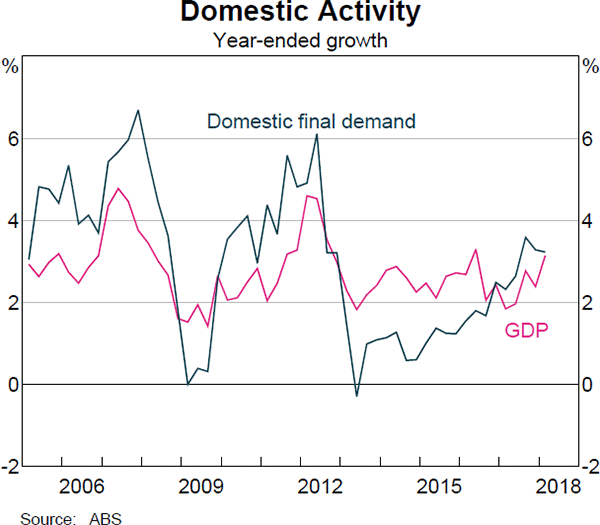
Non-mining business investment has been growing, led by building construction
Private non-mining business investment increased by 10 per cent over the year to the March quarter (Graph 2.2). The main contributor to this growth was non-residential construction activity, which includes private sector spending on both non-residential building and infrastructure-related projects. The increase in non-residential building investment over the year was led by work on offices; this is consistent with strong tenant demand in Sydney and Melbourne, and has occurred against a backdrop of relatively little new supply being added in recent years. Construction of hotels and aged care facilities has also contributed to growth. Private spending on infrastructure has picked up over the past year or so, led by investment in electricity projects (including renewable energy), and is occurring on top of strong public sector expenditure on infrastructure.
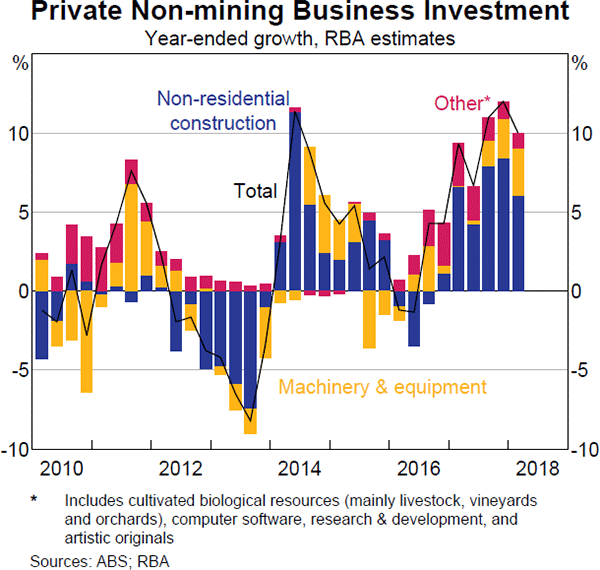
A range of indicators suggests non-mining business investment will continue to expand, albeit at a more moderate pace than over the past year. Non-residential building approvals have declined in trend terms from their peak in mid 2017, and investment intentions for buildings and structures reported by non-mining firms were downgraded in the most recent Australian Bureau of Statistics' (ABS) capital expenditure (Capex) survey (Graph 2.3). Respondents currently expect growth in both buildings & structures and machinery & equipment investment to be relatively subdued over the next year or so. However, the Capex survey excludes some industries and some types of investment, such as investment in software, which liaison suggests has been a focus for many firms recently.[1]
Moreover, the outlook for non-mining business investment continues to be underpinned by positive demand and financial conditions. Survey measures of overall business conditions remain at high levels, and measures of capacity utilisation and expected investment have increased over the past year, particularly in the goods-related sector (Graph 2.4). Corporate profit growth in the non-mining sector has risen over the past year, which should support firms' ability to finance new investments, and financial conditions remain accommodative more broadly (see ‘Domestic Financial Conditions’ chapter). Underlying demand remains supportive of non-residential building activity: information from the Bank's liaison program suggests that tenant demand for new office space is expected to remain strong and improved conditions in the tourism sector have been positive for plans to construct hotels. Consistent with this, the stock of private building work yet to be done has increased over the past year, particularly for offices and tourism-related building. The pipeline of private infrastructure investment has also increased, led by road projects.
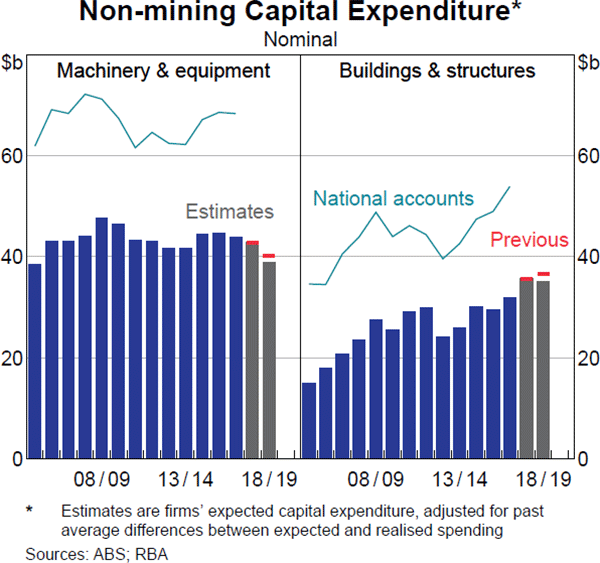
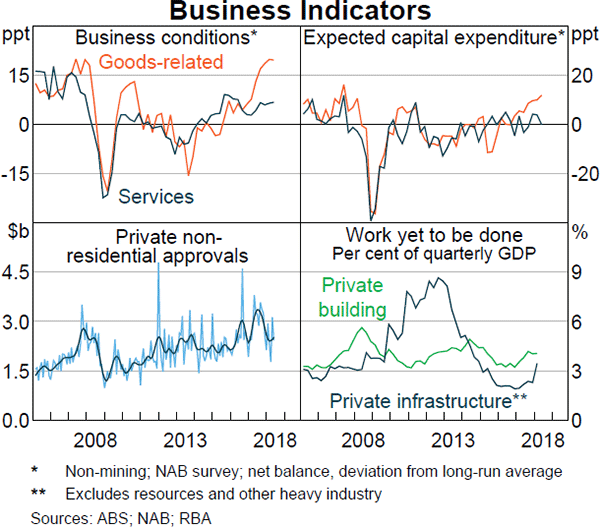
Public infrastructure spending is also supporting growth
Public investment in infrastructure remains high as a share of GDP (Graph 2.5); in real terms, public infrastructure investment has risen by 7.5 per cent over the year. In particular, work done on transport projects has increased significantly over the past few years and the pipeline of work to be completed remains large. The recent federal budget announced an additional $25 billion in infrastructure projects, mostly in road and rail. Liaison with private sector firms has indicated that spillovers from public infrastructure projects have supported demand for business services, particularly in New South Wales and Victoria.
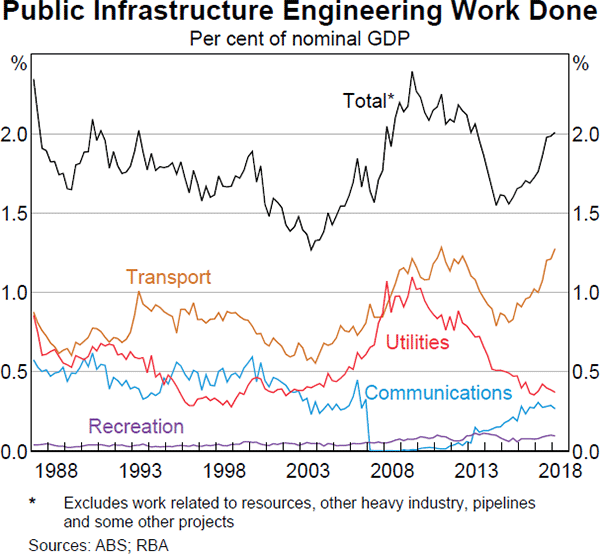
Public consumption grew by 5.1 per cent over the year. Public consumption covers a range of services provided to the community, such as education, health and defence. Recent growth has been supported by spending on the National Disability Insurance Scheme and pharmaceutical benefits. Public demand, which includes both consumption and investment, increased by 5.6 per cent over the year to the March quarter and contributed 1.3 percentage points to GDP growth. Meanwhile, government transfer payments to households grew modestly over the past year. These payments include unemployment and family benefits and the aged pension, and account for a significant share of gross government expenditure; they are counted as household income rather than public consumption or investment in the national accounts.
Overall, the consolidated underlying cash deficit of the federal and state governments is projected to have been smaller in 2017/18 than previously expected, largely due to stronger projected revenues at both the state and federal levels (Graph 2.6).
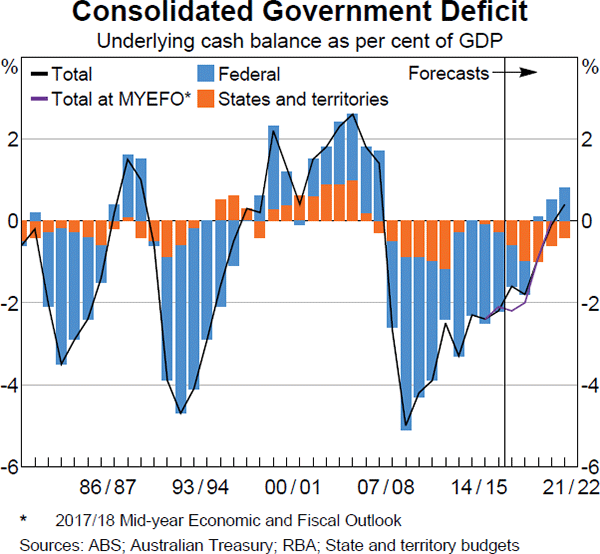
The decline in mining investment has almost run its course
Mining investment fell further in the March quarter, as construction work on the remaining liquefied natural gas (LNG) facilities continued to approach completion (Graph 2.7). Information from the Capex survey and the Bank's liaison program continues to suggest that mining investment will decline further beyond the June quarter, but that the largest subtractions from GDP growth have already occurred. Further out, mining investment is expected to stabilise and then gradually increase as firms invest to sustain production.[2] Liaison with firms also suggests there has been a pick-up in mineral exploration activity over the past year, although this remains below levels seen earlier in the decade.
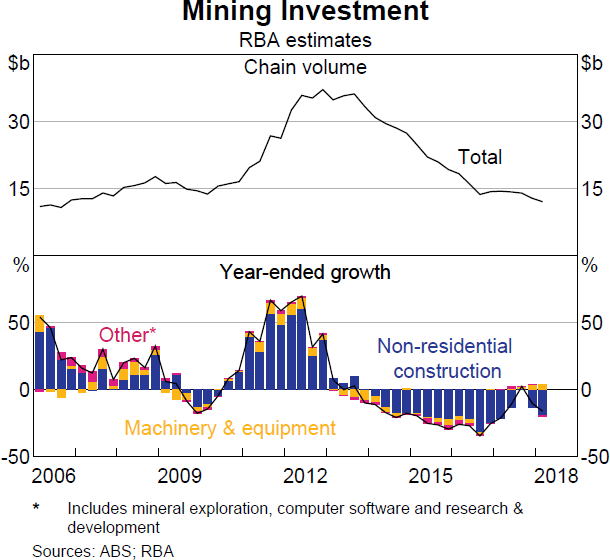
Stronger investment is boosting imports
Growth in import volumes has picked up over the past year or so, in line with the strength in private non-mining business investment and public investment, which are relatively more import-intensive components of expenditure (Graph 2.8). Consistent with this, while growth in imports has been broadly based across all major subcomponents over this period, a key driver has been capital imports, such as machinery and industrial equipment.

Unfavourable weather conditions have weighed on the rural sector
Over the year to the March quarter 2018, farm GDP and rural exports both declined by around 15 per cent (Graph 2.9 and Graph 2.10). A large part of this decline reflects a return to lower levels following a record winter crop harvest in 2016/17. However, recent below-average rainfall across eastern and southern Australia has also adversely affected conditions over the first half of 2018.
Rural exports declined by around 5 per cent in the March quarter, led by declines in exports of cereal grains (in part because of delays in harvesting due to weather conditions) and other rural goods. Meat exports increased as producers responded to the dry conditions by increasing slaughter rates. Preliminary data for the June quarter suggest rural export volumes increased. While this partly reflects responses to drier conditions (such as further herd de- stocking), rural exports are also being supported by strong global demand for agricultural commodities. However, the persistence of drought conditions (in terms of rainfall deficiencies) in recent months in several states is likely to affect rural output adversely in the period ahead.
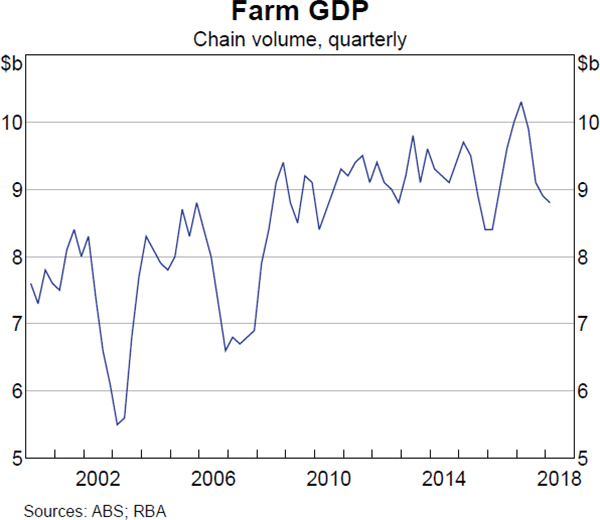
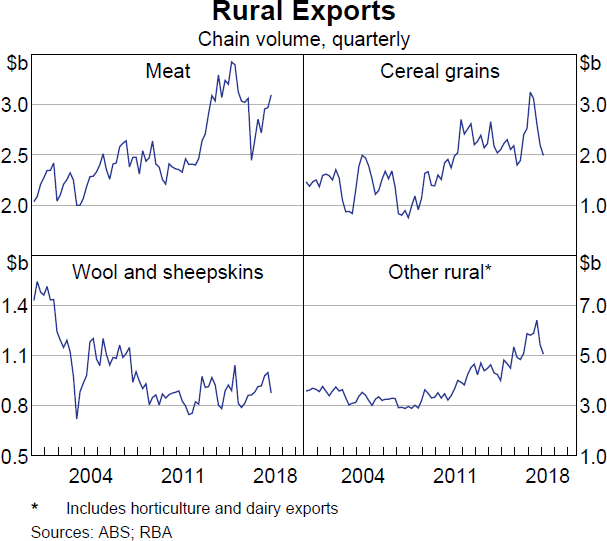
Non-rural exports have been growing strongly
Total export volumes increased strongly in the March quarter, driven by resource exports (Graph 2.11). The increase in LNG exports was particularly large as recently completed projects in Western Australia ramped up production. Non-monetary gold exports also increased strongly; however, this component is volatile from quarter to quarter. Coal export volumes rebounded in the quarter as earlier supply disruptions were largely resolved.
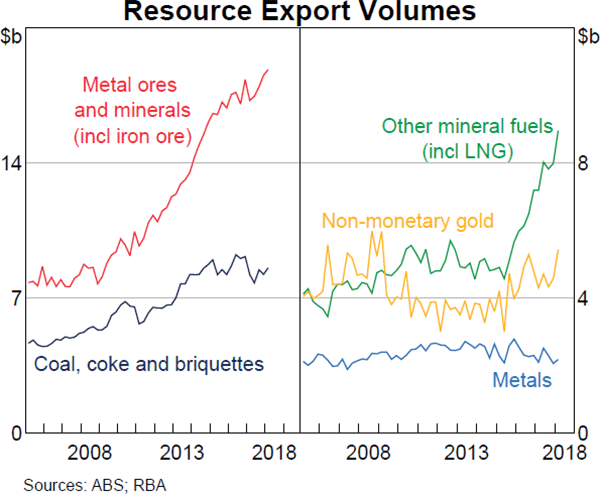
Resource exports have contributed significantly to GDP growth over recent years as additional productive capacity has come online. Further increases in exports are expected over the next year as the two remaining LNG projects are completed and production ramps up. Iron ore volumes are expected to increase a little further over the next few years, driven by productivity improvements from Australia's major producers. Other resource commodities are also expected to contribute modestly to GDP growth over the coming year as new projects are completed and existing mines increase production (see ‘Box C: Outlook for Non-ferrous Metal Exports’).
The strength in resource export volumes, alongside increases in bulk commodity prices, has seen the trade balance move into surplus and the current account deficit narrow (Graph 2.12). The net income deficit widened modestly in the March quarter, consistent with a pick-up in revenues in the largely foreign-owned mining sector (particularly as LNG export volumes have ramped up).
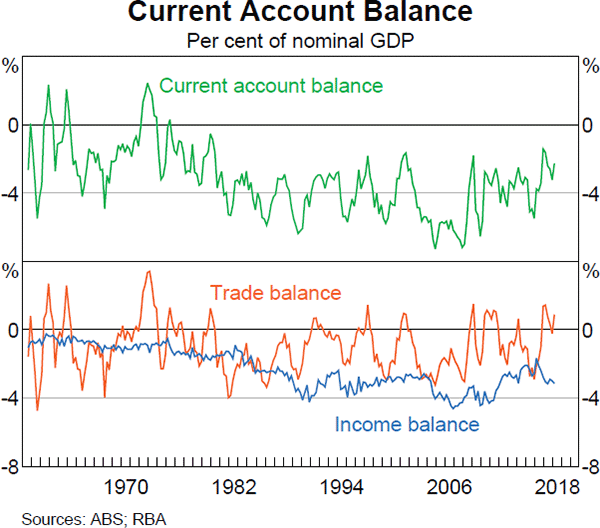
Non-resource export volumes have been little changed over the past year, as higher services and manufactured exports have offset lower rural export volumes. Service and manufactured export growth has been supported by the continued economic expansion in Australia's major trading partners.
Growth in household disposable income has picked up …
Growth in nominal household disposable income has picked up in recent quarters. Over the year to the March quarter, income rose by 2.8 per cent, although it remains below its 20-year average of around 6 per cent (Graph 2.13). Most of the increase in household income growth over the year was due to stronger growth in compensation of employees, reflecting the pick-up in the total number of hours worked, as well as a recovery in average earnings per hour worked (see ‘Inflation’ chapter). Other sources of household income were flat over the year.
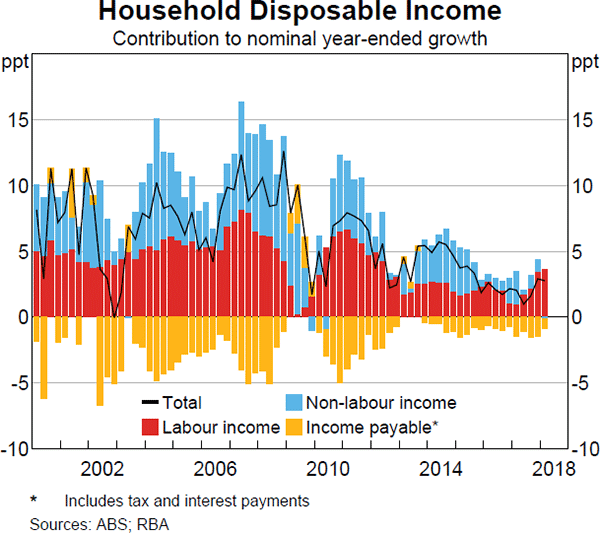
… and growth in household spending has been maintained
Household consumption growth has been a bit more volatile from quarter to quarter over the past year than usual but has been fairly stable in year-ended terms at around 3 per cent (Graph 2.14). Growth in the March quarter was just 0.3 per cent but this weakness was narrowly based in consumption of recreation and cultural services and expenditure at hotels, cafes & restaurants. In recent releases of the national accounts, there have been some large upward revisions to the recent history for these categories due to changes in the measurement of overseas travel services. Meanwhile, growth in goods consumption increased over the year, supported by expenditure on clothing, furnishing and recreational goods.
Early indicators for the June quarter point to ongoing year-ended consumption growth of around 3 per cent. Retail sales volumes grew by 1.2 per cent in the June quarter, suggesting further solid growth in goods consumption, although motor vehicle sales to households declined by 5 per cent (Graph 2.15). Measures of consumer sentiment continued to increase in June and July, and are above average. Households' sentiment towards their own finances, which tends to be more correlated with consumption growth, is little changed and remains around its long-run average. Liaison with retailers suggests that underlying trading conditions have remained stable in recent months.
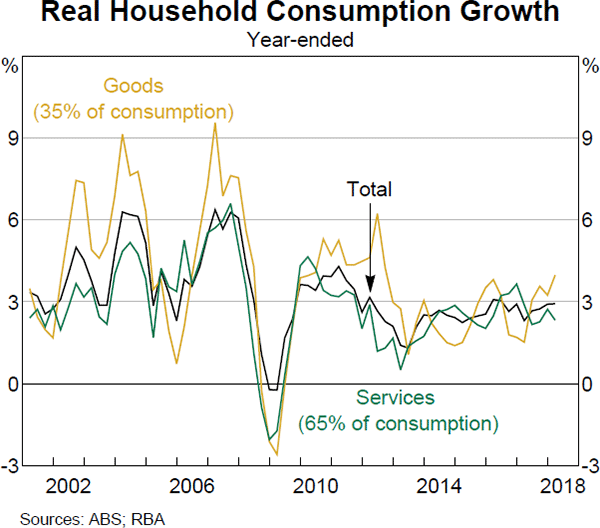

Household spending remains a source of uncertainty for the growth outlook
The prospect of continued low growth in household income remains a risk to the outlook for household consumption, especially given high levels of household debt. In recent years, consumption growth has been relatively resilient and has generally exceeded income growth, which has been associated with a decline in the rate of household saving (Graph 2.16). But consumption and income growth have been more in line of late, largely as a result of the modest pick-up in income growth, and the household saving ratio has been more stable.
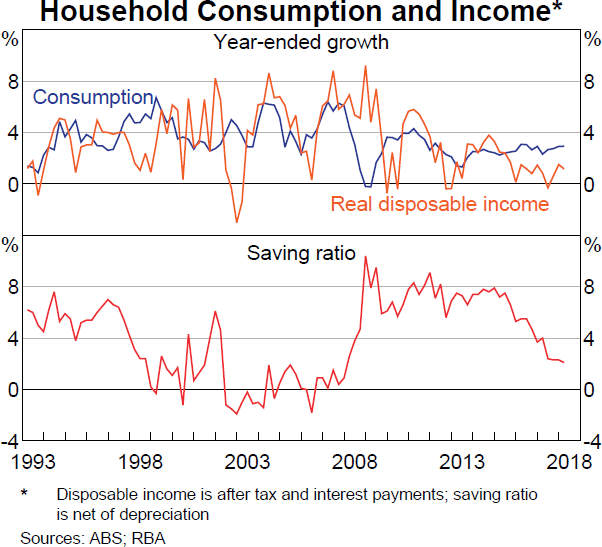
As discussed in the ‘Domestic Financial Conditions’ chapter, growth in household credit, particularly for investor housing, has slowed in recent months. Accordingly, the ratio of household debt to income is estimated to have been stable in the June quarter but remains high following several years of growth. At the same time, growth in household net wealth has eased along with housing prices (Graph 2.17). However, this follows several years of strong growth; households' net wealth has increased by an average annual rate of 6.8 per cent since 2012.
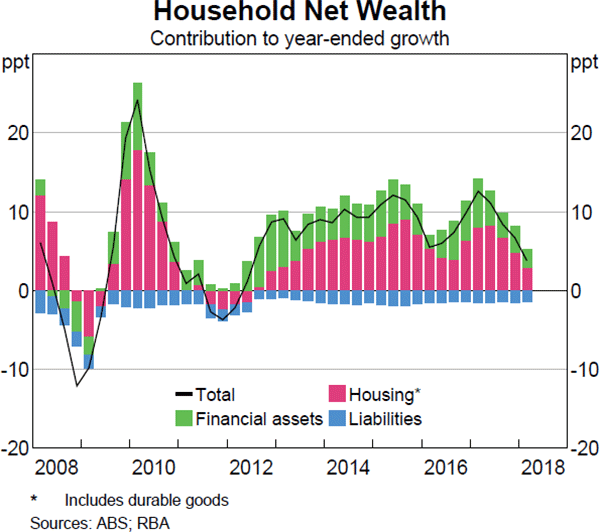
Conditions in the established housing market remain subdued
In most capital cities, conditions in established housing markets eased further in the first half of 2018. National housing prices declined by 2½ per cent over the year to July, driven by developments in Sydney and Melbourne. The rate of price declines has steadily increased in Melbourne over recent months; however, price declines in Sydney remain smaller than in late 2017. Housing prices in Sydney have declined by around 5½ per cent from their July 2017 peak, while in Melbourne, prices are around 3 per cent lower than their November 2017 peak. In general, prices for more expensive properties in Sydney and Melbourne have fallen the most, though prices have declined in the middle market segment recently (Graph 2.18). Other housing market indicators, such as auction clearance rates, have also eased in both cities, and turnover declined in the first half of the year. Detached house prices in Brisbane have been little changed of late, while housing prices in Perth have continued to decline gradually (Graph 2.19). In contrast, housing prices in Hobart have grown strongly to be 12 per cent higher over the year to July.
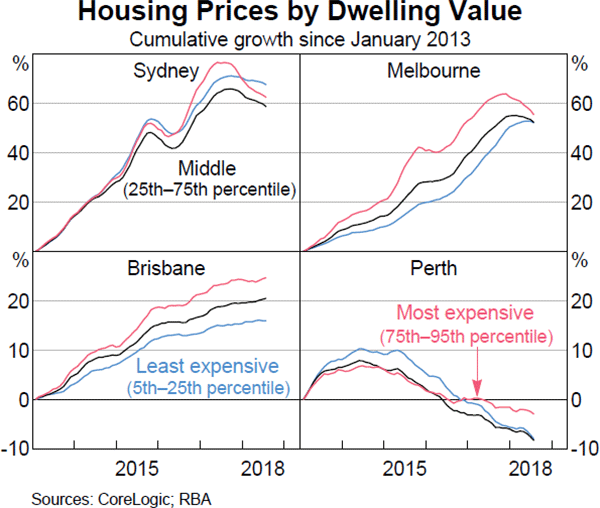
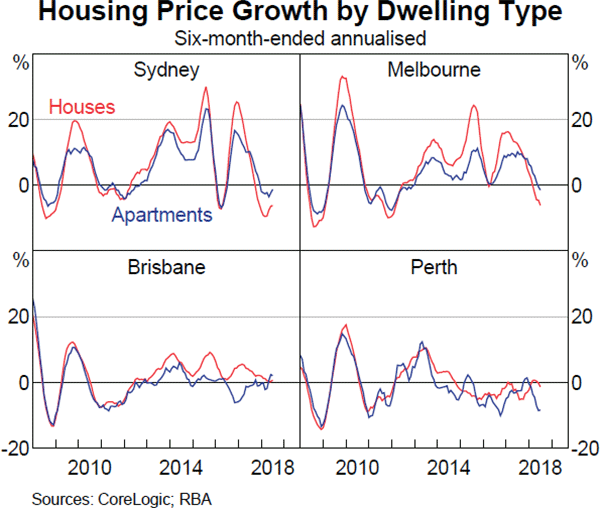
In the rental market, the significant increase in the supply of new dwellings completed and available for rent in the east coast capital cities over recent years has been absorbed by strong population growth. In Melbourne and Canberra, demand has outstripped supply and vacancy rates have declined (Graph 2.20). In Perth, the vacancy rate has declined from the peak levels seen in 2017, but remains high. Rent inflation remains low in most cities (see ‘Inflation’ chapter).
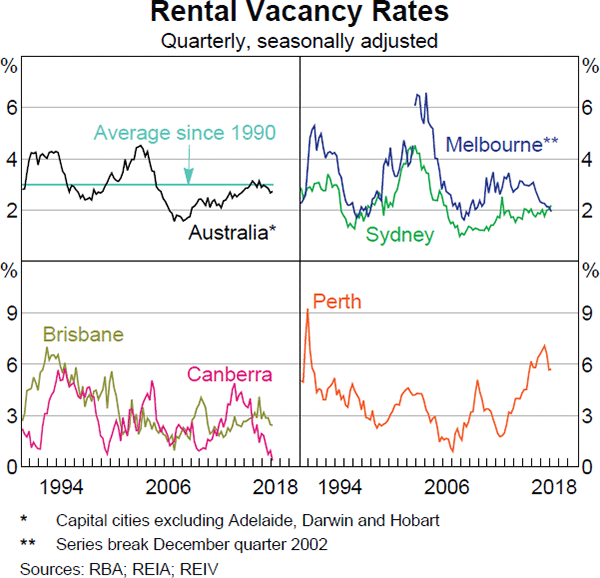
New dwelling investment is expected to remain steady at a high level
New dwelling investment has risen to high levels in recent years, supported by strong population growth and encouraged by higher housing prices. The construction of higher-density housing in the eastern states has driven much of this upswing in activity, while the pick-up in the construction of detached houses has been more modest (Graph 2.21). Alterations and additions, which make up around one-third of dwelling investment, have contributed relatively little to growth during the latest cycle.
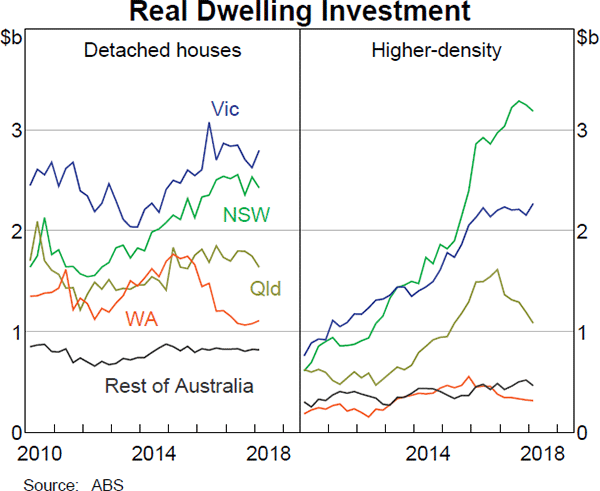
Liaison with developers in the major east coast cities indicate that sales of off-the-plan apartments have declined over the past year, driven by weaker demand from domestic investors and foreign buyers. Demand for new detached housing is also reported to have eased a little in recent months but remains high, supported by strong population growth. Building approvals have declined a little from their peak, consistent with the reported easing of demand. Construction activity is nevertheless expected to remain at a high level for some time yet as a result of the large pipeline of work yet to be done, especially in New South Wales and Victoria (Graph 2.22). In Sydney, liaison contacts report that the higher-density residential construction sector remains around capacity, limiting the pace at which the pipeline can be worked through.
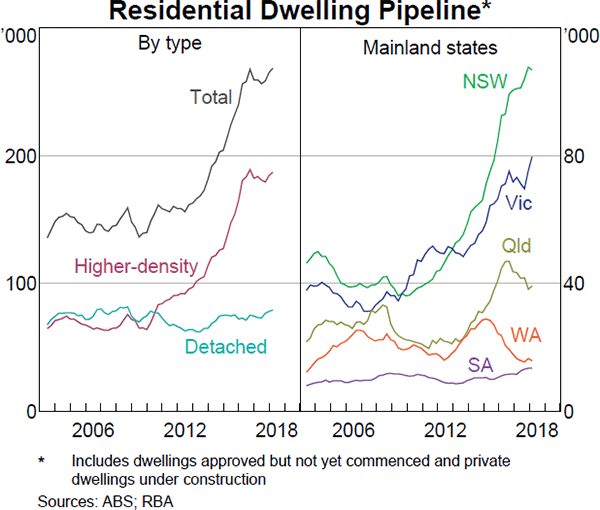
Employment growth remains above population growth, but has moderated
Employment grew at an annualised pace of around 2 per cent over the first half of 2018. This is above growth in the working-age population and follows very strong employment growth of around 3½ per cent over 2017. Most of the increase in employment in 2018 to date has been in part-time employment (Graph 2.23). As such, the part-time share of employment is around its record high. However, average hours worked have been steady in trend terms over the past few years because part-time workers have worked more hours per week on average.
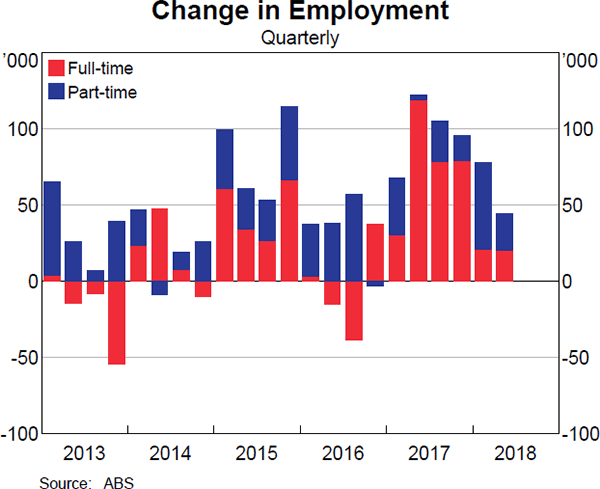
The household-based Labour Force Survey suggests that employment growth over the year to May was strongest in the health care & social assistance and construction industries. Indeed, over 2017, these two large industries are estimated to have contributed over one-half of the employment growth in the economy. This is consistent with continued growth in the demand for carers of the elderly and disabled, while employment in the construction industry has been supported by the high levels of residential and infrastructure building activity underway.[3] Employment growth also appears to have picked up in business services over the past year, particularly within the professional, scientific & technical services industry.
The unemployment rate has declined a little …
In trend terms, the unemployment rate is 5.4 per cent and has declined a little over the past year (Graph 2.24). The unemployment rate remains a bit less than ½ percentage point above conventional estimates of full employment in Australia, indicating that there is still spare capacity in the labour market. A broader measure of labour market underutilisation – which captures the additional hours that underemployed people would like to work as well as hours sought by the unemployed – has also remained fairly stable over the past year at a level consistent with there being some spare capacity remaining. The trend unemployment rates in New South Wales and Victoria are the lowest across Australia, consistent with the stronger economic activity in these states. Meanwhile, the trend unemployment rate remains elevated in Western Australia and Queensland.
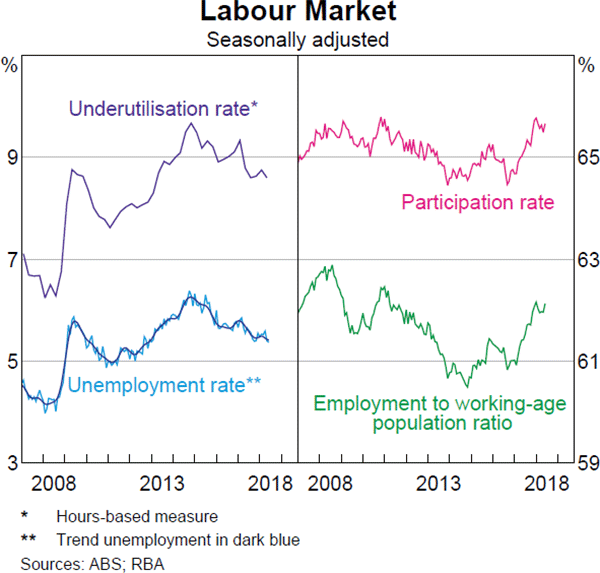
A number of other indicators suggests that labour market conditions have continued to improve. Households appear to be more confident about their employment prospects, as the share of employed persons expecting to voluntarily leave their current employer has trended higher over the past year, while the share expecting to leave because their employer is closing/downsizing has continued to trend lower (Graph 2.25). The trend unemployment rate of younger workers (aged between 15 and 24 years), who make up a large share of spare capacity in the labour market, appears to have declined sharply over the first half of the year.[4] More broadly, short- and medium-term unemployment (those unemployed for less than one year) has also declined a little as a share of the labour force, although there has been little reduction in the share of the labour force that has been unemployed for more than a year.
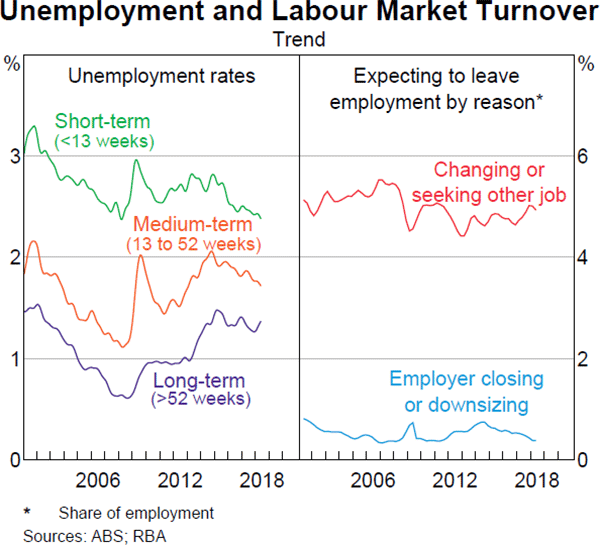
… while the participation rate is around record highs
The strong employment growth over recent times has been accompanied by an increase in labour force participation, which has meant that the unemployment rate has been little changed. The labour force participation rate is currently around 65½ per cent, which is close to its historical high. The increase in the participation rate over the year reflects the fact that as economic conditions improved and employment grew strongly, more people chose to enter the labour force or deferred retiring (Graph 2.26).[5] As tends to be the case, the participation of younger people, 25–54 year-old females and older males has been relatively responsive to changes in economic conditions over the past year. Alongside these cyclical responses, there has also been a longer-run upward trend in the participation rate for females and older workers.
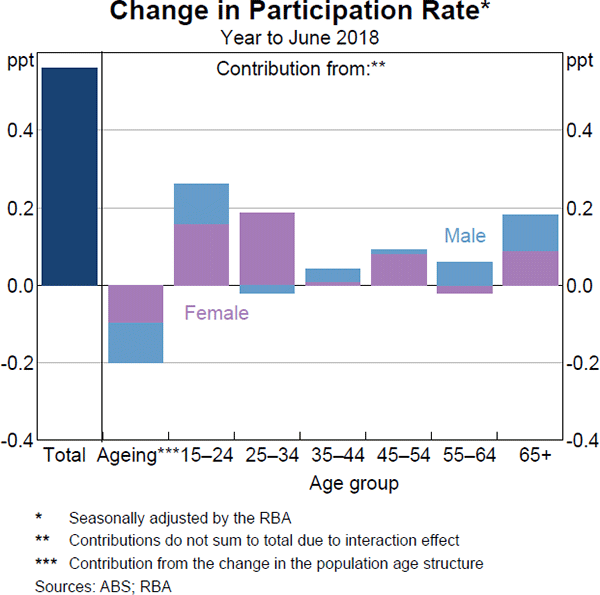
Leading indicators of labour market conditions remain positive
Overall, the range of labour demand indicators points to above-average growth in labour demand over the remainder of this year. In particular, business surveys suggest hiring intentions remain well above average, while job vacancies have risen to a record high level relative to the size of the labour force. Over the past year, there has been particularly strong growth in job vacancies within the business services sector, namely in the administrative & support services and professional, scientific & technical services industries. Consistent with the steady increase in mining industry vacancies, there has been a more recent pick-up in job vacancies in Western Australia, while job vacancies remain at a high level as a share of the labour force in Victoria and New South Wales (Graph 2.27).
In addition, information from the Bank's liaison program provides evidence of continued labour shortages in some parts of the economy such as construction and information technology. These are most acute in the eastern states, partly reflecting the combination of strong residential, commercial and public infrastructure construction activity.
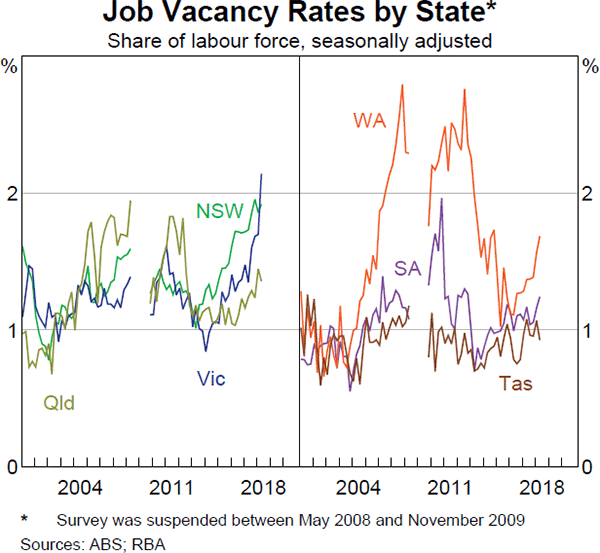
Footnotes
The Capex survey does not cover certain industries, including agriculture, health and education, and does not cover certain types of investment, such as software and research & development. [1]
See Jenner K, A Walker, C Close and T Saunders (2018), ‘Mining Investment Beyond the Boom’, RBA Bulletin, March, viewed 7 August 2018. [2]
The ABS recently released the first issue of the quarterly Australian Labour Accounts. The Labour Accounts dataset is believed to be a better indicator of industry labour market trends because it is constructed from a range of sources, including business surveys. However, these data are currently only available up to the September quarter 2017. [3]
See Dhillon Z and N Cassidy (2018), ‘Labour Market Outcomes for Younger People’, RBA Bulletin, June, viewed 7 August 2018. [4]
See RBA (2018), ‘Box B: The Recent Increase in Labour Force Participation’, Statement on Monetary Policy, May, pp 33–34. [5]